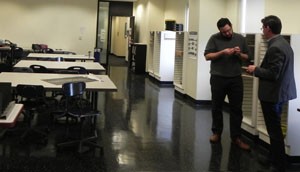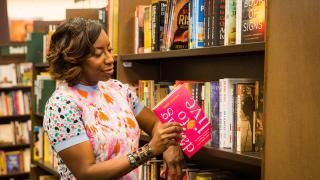

Assistant Professors Patrick Beauchesne, left, and John Chenoweth look at artifacts in the Archaeology Lab. Classes started to use the Lab this semester.
“Hands-on experience and research are critical for recognizing that human knowledge isn’t what you Google,” said John Chenoweth, assistant professor of anthropology. “It’s important to learn through doing, seeing and making connections with the artifacts you’ve found. We are thankful to now have this new Archaeology Lab to do that with our students.”
The Archaeology Lab, which formerly was housed in one of the Henry Ford Estate cottages, is on the third floor of the CASL Building.
The generous-sized room has tables for student seating, storage trays for field school finds, a washbasin and scrubbing devices to clean artifacts, a small library to supplement the Internet, and lab equipment like liquid nitrogen to measure porosity and a colorimeter to measure color.
“We have the ability to measure things in an objective manner through equipment so that we can more accurately type the items,” Chenoweth said. “In archeology, it’s important to type things because then you can go back to the typology and look at things like, ‘Who made it?’ ‘How old is it?’ ‘Is this the fine china they used during the holidays or the Styrofoam of the 18th century?’
“It’s after those kinds of questions are answered that we can talk about higher-level connections like: ‘What do these items tell us about class, economic status or the cultural identity of the people who used them?’”
Patrick Beauchesne, assistant professor of anthropology, said the new lab nicely accommodates students in space and academic needs.
"In this room, I can set up learning stations and the students can move around. We couldn’t do that in our old space. This is a much more effective teaching environment,” said Beauchesne, who can now better incorporate lab components into his courses for students to participate much more effectively in activities like working with replicas of the human skeleton and using microscopes to look at slides of bones for teaching purposes and data analysis.
Beauchesne said it was hands-on research in an undergraduate course that sparked his interest in anthropology. He hopes to do the same for his students, regardless of their major.
“It’s touching the past—literally. A textbook or PowerPoint slide doesn’t get you the same feeling as being in a room with objects that people created, touched and used,” he said.
Chenoweth said even though the Archaeology Lab will be used to look at “stuff”—and he said archaeologists have of a lot of stuff—the items aren’t what the discipline is all about.
“I’m not studying plates to study plates,” he said, holding a piece of an 18th century English delftware dish. “I’m doing it to learn about people. But the stuff is all that you have to learn about the people in some cases. The common people didn’t get to say what went in the history books. But we can learn a bit about them through sorting, typing and cataloguing these items. And this is the place where we’ll do it.”




